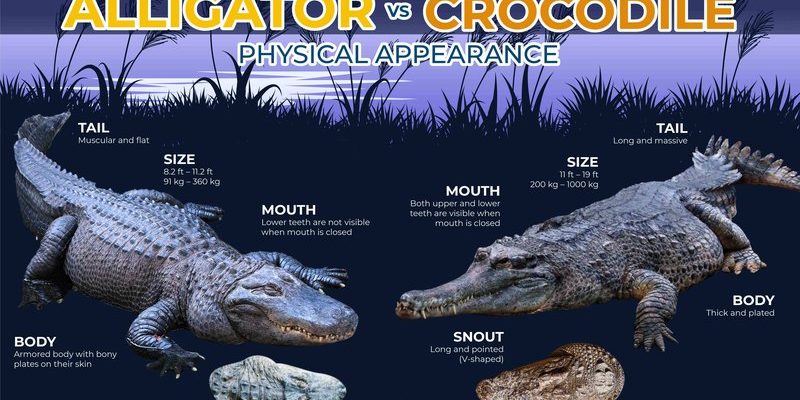![Crocodile Vs. [Similar Species] - How They Compare](https://gudri.com/wp-content/uploads/2025/06/Crocodile_Vs___Similar_Species____How_They_Compare_image_0.jpg)
So, what exactly sets these two formidable reptiles apart? Let’s break it down over a cup of coffee. You might discover that, while they share some similarities—like their love for sunbathing and their impressive bite force—they also have distinct traits that make each one unique. Understanding these differences isn’t just for trivia night; it also helps you appreciate the diversity of life on our planet.
Physical Differences: Size and Shape
When it comes to physical appearance, crocodiles and alligators don’t just share a name—they also share some body characteristics. However, they have distinctive traits that make it pretty easy to tell them apart at a glance.
First off, let’s talk about their snouts. Crocodiles have long, pointed snouts that come to a V shape, while alligators boast wider, U-shaped snouts. It’s almost like the crocodile has a bit more of a refined look, whereas the alligator seems more stocky and robust. This difference isn’t just for aesthetics; it actually reflects their eating habits. Crocodiles are more likely to prey on fish, while alligators prefer larger mammals.
Size-wise, crocodiles tend to be the bigger of the two. The largest crocodile species can grow over 23 feet long! In contrast, most alligators max out around 19 feet. So, if you spot a reptile that looks like it could swallow a small car, you’re likely looking at a crocodile.
Color and Skin Texture
Next, let’s discuss the skin color and texture, which can also help you identify these reptiles more easily. Crocodiles usually have a lighter, olive-brown color with a more rugged, rough appearance. Think of it as their natural camouflage for blending in with rivers and swamps.
Alligators, on the other hand, sport a darker, almost blackish hue. Their skin has a smoother texture, which just adds to their bulkiness. While the differences may seem subtle, they can be crucial for identification—especially if you’re observing them in the wild.
One interesting aspect of their skin is the protective armor. Both animals have bony plates embedded in their skin called osteoderms. These plates serve as armor, making them tougher to prey on. Crocodiles, however, have a more extensive array of these bony plates, which adds to their rugged appearance.
Behavioral Traits: Temperament and Habitat
Moving on to behavior, crocodiles and alligators have quite different temperaments. Crocodiles are generally considered more aggressive, especially if they feel threatened. You might be wondering why that is. Well, crocodiles tend to have a more territorial nature, meaning they won’t hesitate to defend their space.
Alligators, in contrast, are often seen as more docile. Yes, they can be aggressive too, but they tend to be a bit more laid-back, especially when it comes to humans. While you should never approach either species, an alligator may be less likely to charge at you. Their calm demeanor can sometimes be disarming—until you remember they’re still wild animals.
When it comes to habitat, both prefer freshwater environments like swamps, lakes, and rivers. However, crocodiles can tolerate saltwater, which is why you might spot them in coastal areas. Alligators prefer freshwater and are rarely found in saltwater regions. This difference in habitat can be key when trying to spot one versus the other.
Dietary Preferences and Hunting Techniques
So, what do these reptiles eat? Well, they have similar diets but go about their hunting in different ways. Crocodiles are opportunistic predators. They’ll eat whatever comes their way, from fish to birds, and even larger mammals if they have the chance. Their aggressive nature helps them snag a wide variety of prey.
Alligators prefer to hunt smaller animals and are known to target fish, amphibians, and even small mammals. Their hunting style tends to be more stealthy. They often lie in wait and use their powerful jaws to snap up unsuspecting prey. It’s like they play the long game—waiting patiently until the perfect moment strikes.
Both creatures have incredibly strong bites, but the way they use this strength can differ. Crocodiles are known for their gripping bite, allowing them to hold onto larger prey, while alligators tend to use a more crushing bite. This is thanks to their different jaw structures and muscle configurations.
Reproduction: Eggs and Nesting
When it comes to reproduction, crocodiles and alligators follow similar yet distinct patterns. Both species are oviparous, meaning they lay eggs. However, how they care for those eggs differs.
Crocodiles often build nests in vegetation near water. They cover their eggs, which can number anywhere from 20 to 80, with leaf litter to keep them warm. This method helps protect the eggs from predators. After about 80 days, the eggs hatch, and the mother crocodile will help carry the young to water.
Alligators also build nests, usually made of mud and plant debris, but they create theirs on land. They typically lay fewer eggs, around 15 to 50, and also provide parental care. Interestingly, the temperature at which the eggs are incubated can determine whether the hatchlings are male or female. Warmer temperatures generally produce males, while cooler temperatures yield females.
Knowing the differences between crocodiles and alligators isn’t just fascinating—it’s important for conservation efforts and safety. As we encroach on their habitats, understanding their behaviors and needs helps us coexist peacefully. After all, both creatures play crucial roles in their ecosystems.
So next time you find yourself in a zoo or on a nature hike, see if you can spot the differences. Whether you’re gazing at a crocodile’s sharp snout or an alligator’s darker skin, you’ll appreciate the unique traits that make each species special. Remember, these incredible reptiles have been around for millions of years. They’re more than just creatures of the water; they’re living links to our planet’s distant past. Keep this in mind, and you’ll find yourself viewing the natural world with fresh eyes!

